Pruning plants is easier than you think, and it’s important for a healthy and productive garden.
In this post, you’ll learn everything you need to know about when and how to prune plants, including methods to use, tools, and easy tips for trimming all types of perennials, vegetables, herbs, trees, and shrubs.
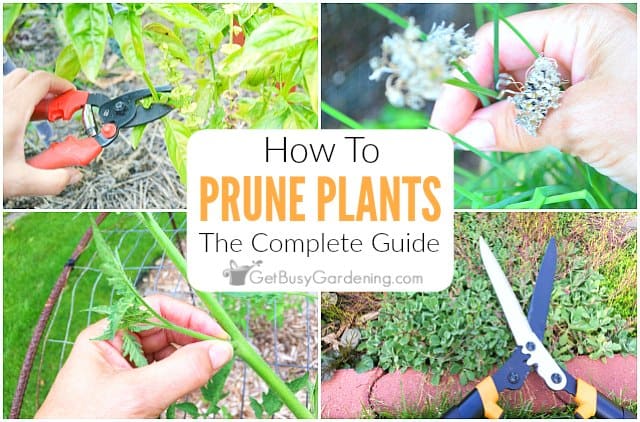
If you’re worried that pruning plants is too complicated, or you’re going to mess it up and kill something, then you’re in the right place!
Pruning plants can be an intimidating topic for new gardeners, and it seems to be one of those things that really stresses people out. But don’t worry! I am going to make this super easy for you.
Whether it’s trimming trees, deadheading flowers, or thinning out plants, I’ll walk you through it all step by step.
In the end, you’ll feel confident that you can successfully learn how to cut back or prune any plant that you want.
The Complete Guide To Pruning Plants
I know pruning plants can sound like a huge scary thing. You might even think that you need to know exactly how to trim every single plant in your yard before you touch any pruning shears.
But that is far from true. Trust me, it’s really not that hard!
First off, instead of thinking of it as a chore all on its own, think of it as something you do on a regular basis as a way to keep your gardens looking tidy. Heck, you’re probably already doing it!
What Is Pruning?
Pruning, also called trimming, is the act of cutting branches, stems, flowers, or other parts of a tree, shrub, or any other type of plant, in a way that is beneficial.
Many types of plants benefit from being trimmed. Some require it on a regular basis, while others will grow just fine even if they are never pruned.
Why Prune Plants?
There are lots of different reasons to prune plants. Not only does it keep your garden looking groomed, it prevents things from becoming scraggly and overgrown.
Regular pruning also helps prevent problems with pests and disease, and promotes healthy new growth, as well as an abundance of blooms and fruit.
While it’s certainly not required for all plants, it can be important so they grow their best, and produce tons of gorgeous flowers, fruit, or veggies for us.
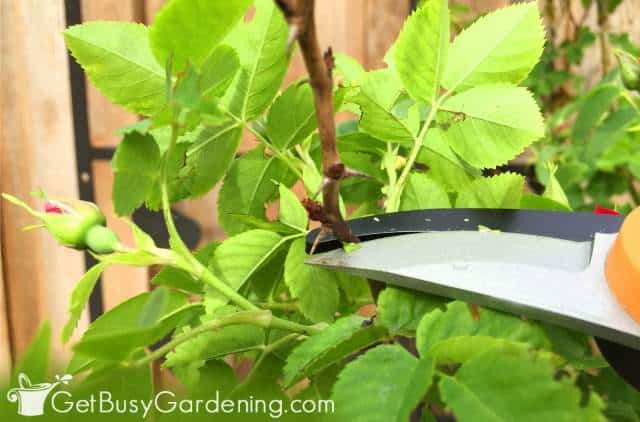
Benefits Of Pruning Plants
Regular pruning is very beneficial for keeping your garden healthy, and looking its best. If you’re not quite sold on it yet, here are some of the most important benefits of trimming plants regularly…
- Promotes plant health – Removing dead or dying branches allows the plant to focus its energy on producing fresh, healthy growth.
- Encourages branching, flowering, and fruiting – Trimming back excess branches, runners, or other extraneous limbs, focuses the plants energy on flowering or fruit bearing branches.
- Controls size and shape – Regular maintenance pruning prevents plants, shrubs and trees from becoming overgrown, and taking over the space. It also keeps them looking shapely.
- Prevents disease – Keeping the garden clear of any dead plant material helps prevent insect pest and disease problems.
Pruning Techniques & Methods
There are lots of techniques you can use for pruning plants, and you may already be familiar with a few of them. You might even be using some of these methods in your garden already.
Deadheading
The term deadheading refers to removing the flowers from a plant after its done blooming. Removing the faded flowers before they have a chance to set seed encourages new blooms, and prevents self sowing.
This also encourages perennials to focus on forming new foliage, and build energy for next year’s blooms, rather than wasting energy producing seed.
This is especially good for aggressive self sowers, like chives, columbine, black-eyed Susan, and salvia.
Deadheading also helps annual flowers, like marigolds, zinnias and geraniums. Removing the spent flowers encourages the plant to produce more buds, giving you a longer bloom time.
For both annuals and perennials, you can simply remove the faded flower, or cut back the entire flower spike. The flower stems can be cut down to the ground, or as low as necessary to hide them from view.
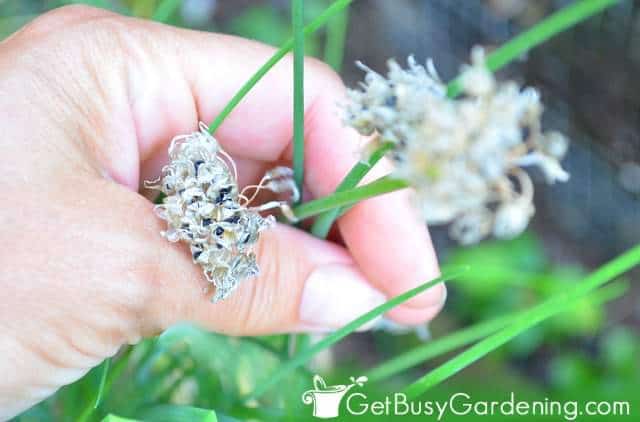
Thinning
When plants become thick and dense in the center, they are more prone to being infected with fungal diseases like powdery mildew.
In addition to that, they can also start to die off in the middle because those crowded center branches get choked out, or don’t get enough sun.
Thinning is a pruning method used to open them up, and allow for better airflow. Remove some of the branches in the center, leaving the healthiest to thrive disease free.
Maintenance Pruning
It’s a good idea to get into the habit of checking your garden regularly, trimming off any dead or diseased leaves. This will keep your gardens healthy and looking their best.
Maintenance pruning is best for removing dead or dying leaves from perennials after they are done blooming for the summer.
This opens up the space around the spent perennial, allowing the others that are currently flowering to really stand out, and giving them plenty of room to grow.
Hard Pruning
If they aren’t pruned on a regular basis, some plants will become so overgrown that the only way to get them back to their original glory is to give them a drastic haircut.
Hard pruning means cutting back a plant so it’s much shorter than it was before. The exact amount depends on the specific plant.
But be careful with this method. Only use it if you know what you’re doing, because some plants won’t grow back if they are over pruned.
Pinching
Sometimes you don’t even need to grab the pruners in order to do some quick trimming. All you need are your fingers.
Pinching is a great way to quickly get rid of dead flowers. But you can also pinch out the tender new growth on some plants to control their shape, size, or bushiness.
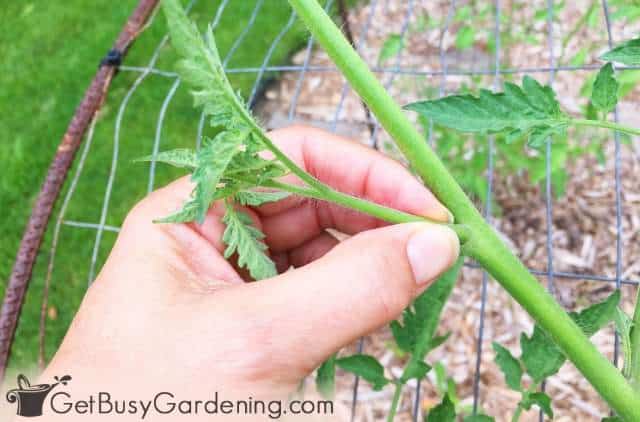
When To Prune Plants
There is a secret for making it super easy to figure out the best time for pruning plants. Are you ready? Here it is…
As a general rule of thumb, you should prune plants after they are done blooming.
That’s it! I mean honestly, how easy is that?!
But, like I said, that is just a general rule. Some need to be pruned more strategically, while others aren’t super fussy. Usually it’s best to trim plants in the late winter or early spring, or during the summer.
Late Winter/Early Spring
Some types of plants, mainly shrubs and trees, will perform best when pruned in the late winter or early spring. This can help prevent disease, and encourage blooming or fruit production.
If you’re unsure of what you’re doing, wait until you see new buds start to form on the plant before pruning. That way, you’ll have a better idea of where to make the cuts on the branches without new growth.
Summer
During the middle of the summer, some areas of the garden can start to look tired, overgrown, and even weedy. To keep your garden looking its best, trim back spent perennials regularly throughout the summer.
This will also help to make the current bloomers stand out, and keep things tidy through the summer. Some plants that are trimmed will even fill out again, and look revitalized.
Don’t cut the foliage of perennials all the way down to the ground in the summer though, unless it has died back on its own. They need their leaves in order to build energy for flowering again next year.
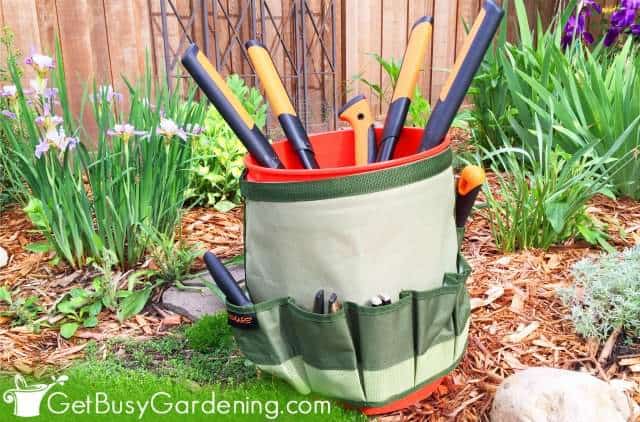
Tools For Pruning Plants
Unless you’re just pinching your plants, you’ll need some pruning tools. Using the right tool for the job will not only make it easier for you, but it will be safer and healthier for your plants too.
Here are a few of the most common types of tools for trimming all kinds of plants, trees, and shrubs. You may not need all of these, but you’ll likely need more than just one.
Hand Pruners
Hand pruners, or pruning shears, are probably the most diverse trimming tool you can own. They are perfect for any kind of small project where you need precision over power.
They are the best choice for deadheading perennials, pruning small branches on woody shrubs or vines, and trimming unruly vegetables.
More than likely, you’ll need more than one pair. The three I recommend every gardener have in their tool shed are a general purpose hand pruner, a pair of micro snips for precision work, and a heavy duty one for thicker branches.
Loppers
Loppers are the next step up from hand pruners, excellent for heavier woody stems and branches up to 1 1/2″ diameter.
Most commonly, loppers come out of the tool shed when the larger shrubs or trees need pruning. They are also good for cutting back thick, woody perennials.
Pruning Saw
A pruning saw is a narrow, hand held serrated blade that is best for branches thicker than 2” in diameter. These branches on fruiting or flowering trees require that extra effort for a clean cut.
The narrow blade allows you to get in tight spaces where branches join, while still being able to cut large limbs.
You can also get an extendable handle for a pruning saw to reach the tallest point of a tree without having to balance on a ladder.
Hedge Trimmer
Motorized hedge trimmers (electric or gas) are the best choice for shaping hedges and shrubs, and they also work great for cutting down perennials during garden cleanup.
The small, sharp blades work best for trimming the narrow tips of branches and new growth, rather than heavier pruning tasks.
Hedge Shears
Hedge shears work similarly to hedge trimmers, but manually. They look like a giant pair of scissors, and are good for cutting large amounts of small stems all at once.
They create smooth, straight lines that are what you want on a hedge or shrub. You can also use them when cutting back perennial grasses or other prolific, narrow stemmed plants at the end of the growing season.
How To Prune Plants
Before getting started, it’s very important that your tools are clean and sharp. You can disinfect them by washing them with soapy water, or simply dip the blades into rubbing alcohol and wipe them clean.
This is especially important to do after trimming off any diseased material, so you don’t end up accidentally infecting other plants.
Get step by step instructions for cleaning and sharpening garden tools here. Below are tips for pruning plants, trees, and shrubs…
Shrubs
Flowering Shrubs (e.g.: lilacs, roses, weigela, russian sage, hydrengea, lavender): Prune back the dead growth down to the first new buds on each stem (or all the way to the ground if there’s no new growth on that stem).
Bushes like lilacs and weigelas can be pruned back a bit shorter every few years to help keep them from thinning out in the middle.
Trees
Blooming & Fruiting Trees (e.g.: linden, cherry, apple, crabapple): Cut off dead or damaged branches at any time of the year.
You can also prune trees to keep them from getting too dense, and allow for better airflow (this is important for fruit trees).
Cut off any suckers growing from the trunk on a regular basis. These suckers not only look bad, they steal energy from the tree.
Get detailed step by step instructions for trimming tree branches here.
Vines
Vines (e.g.: honeysuckle, clematis): Prune off the dead vines that don’t have any new growth on them. This will keep them looking nice, and maintain their shape and size.
Cut down to just above the new leaf buds, and take care not to cut a vine below new growth (sometimes they can get so tangled that it’s hard to see what you’re doing).
Perennial Plants
Perennials can be pruned after they are done blooming. Most of the time, all you’ll need to do is cut back the spent flower stems.
You can also cut back the leaves to make it more shapely. But don’t remove too much of the green foliage, because blooming perennials and spring bulbs need their leaves to build up the energy to flower again next year.
Pruning perennials is totally optional, but it helps to keep the garden from looking burnt out and overgrown in the middle of the summer.
Plus, it’s nice to trim plants that are done flowering so the new bloomers can really stand out. Give overgrown or scraggly looking perennials a good haircut, and remove any yellow, leggy or weak growth.
Vegetables & Herbs
Generally speaking, most vegetables don’t need to be pruned at all, so you won’t have to spend a lot of time on them.
But there are a few veggies that benefit from being trimmed once and awhile, and there are other reasons why you might need to head to the vegetable garden armed with a sharp pair of pruners.
Plants like tomatoes and herbs will benefit from being pruned or pinched regularly during the growing season.
Not only does this promote healthy growth and lots of food production, it also improves air circulation, which helps to prevent disease and fungus issues.
Unruly veggie vines can also be trimmed to control their size, or in order to train them to grow over a wide structure rather than continuing to grow taller and longer.
Pruning also encourages vegetables to focus their energy on ripening the fruit. This trick is especially useful toward the end of the summer when they are heavy with unripe fruit.
Trimming the new foliage, and pinching off the flowers will allow the plant to focus on ripening the fruit that’s already on the vine, giving you a better late-season harvest.
FAQs About Pruning Plants
In this section, I’ll answer some of the most frequently asked questions about pruning plants. If you can’t find an answer to your questions anywhere, then ask it in the comments below.
Does pruning hurt plants?
As long as you follow the proper techniques, then no, pruning does not hurt plants. The main risks are over pruning plants that won’t grow back, and spreading disease by using dirty or dull tools.
Does trimming plants help them grow?
Yes, absolutely. Proper pruning is very beneficial to plants. It helps them grow tons of flowers or fruit, and keeps them healthy. See a full list in the section above called “Benefits Of Pruning”.
What is the purpose of pruning?
In a nutshell, pruning allows plants to focus their energy on producing healthy new leaves, flowers and fruit. Regular trimming also prevents disease and insect infestations, keeping your garden much healthier. See the section above called “Why Prune Plants” for more information.
Should I cut off dead flowers?
Yes. Cutting off spent flowers is a great way to extend the bloom time of a plant, and get even more flowers. See the “Deadheading” section above for more details.
Pruning plants is an important part of successful gardening, but it doesn’t have to be intimidating or time consuming. Doing just a little trimming at a time goes a long way to keep your garden healthy and looking great all season long.
More Posts About Pruning Plants
- How To Prune Chives & Deadhead The Flowers
- How To Deadhead Petunias By Pinching & Pruning
- How To Prune Tomatoes For Maximum Production
- How To Prune Basil The Right Way
- How To Prune A Jade Plant
- Pruning Rosemary To Promote Growth & Larger Yields
- How To Prune A Wandering Jew Plant (Tradescantia)
- How To Prune A Money Tree (Pachira aquatica)
- How To Prune Hydrangeas Step By Step
Share you tips for pruning plants in the comments section below.
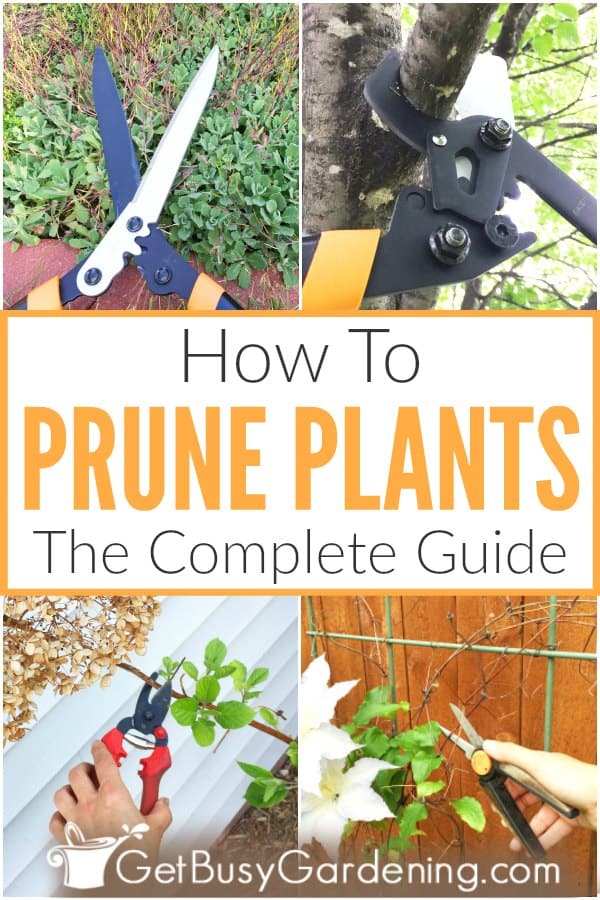
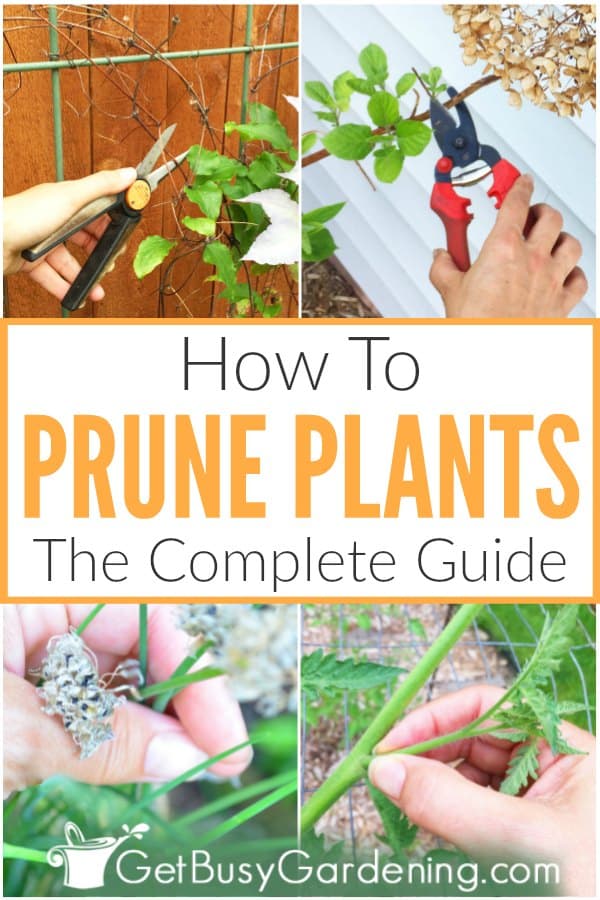
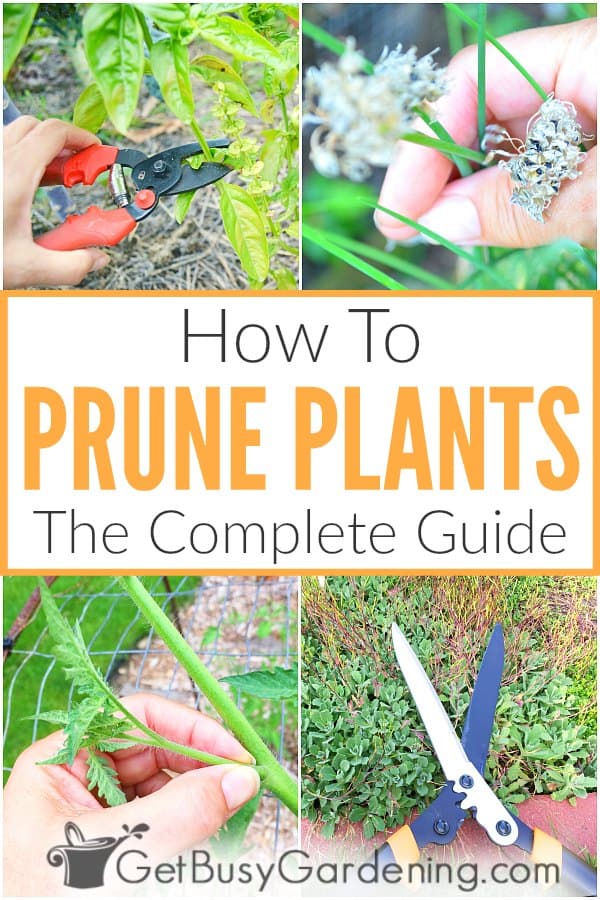

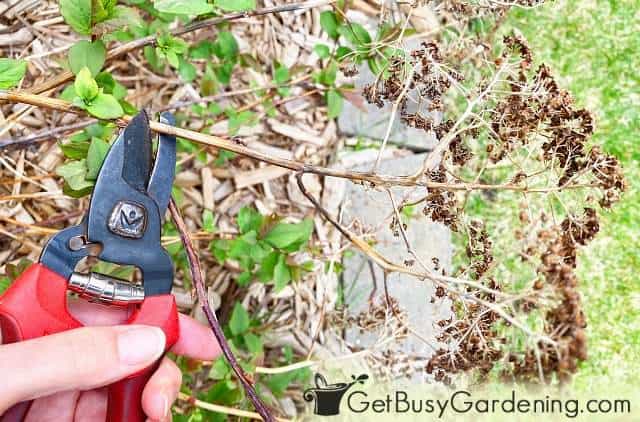
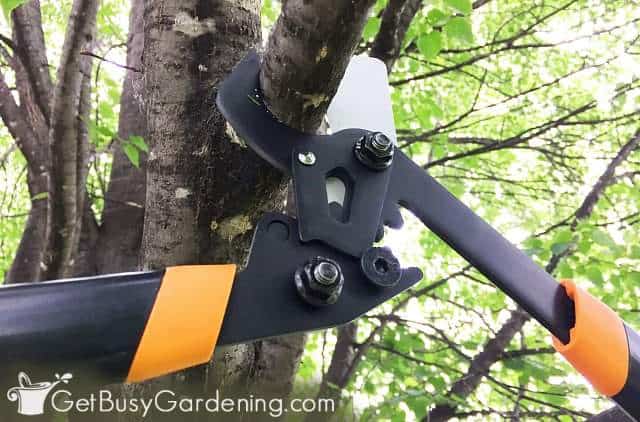
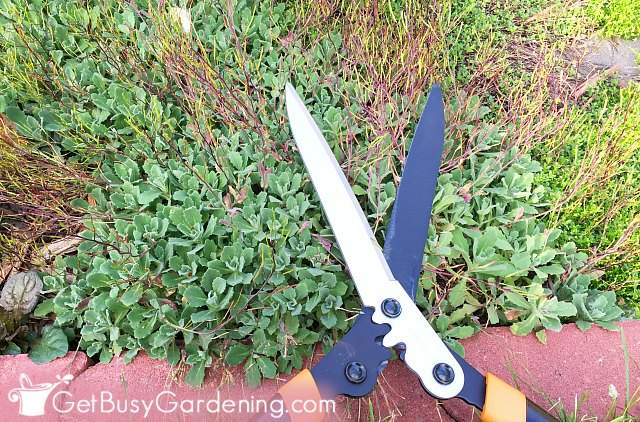
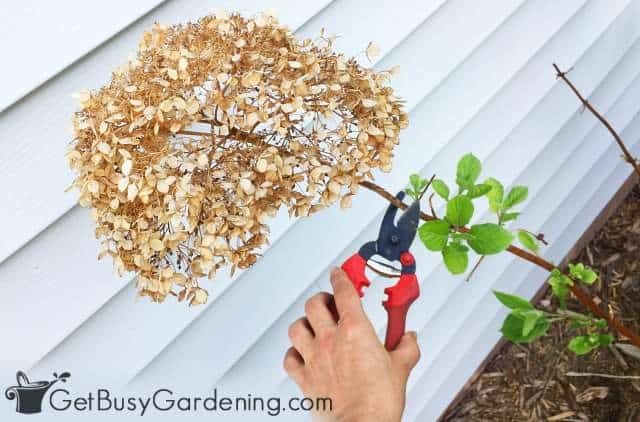
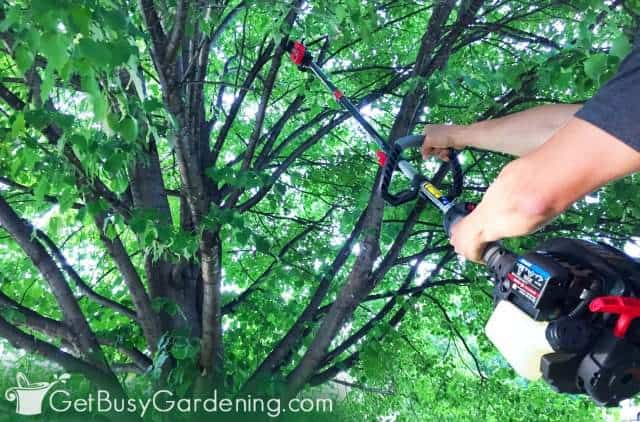
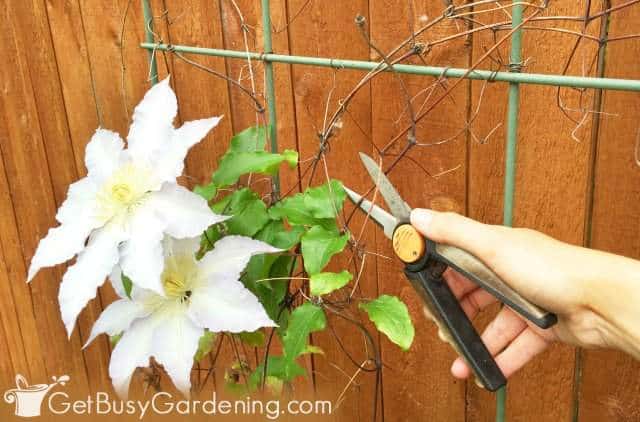
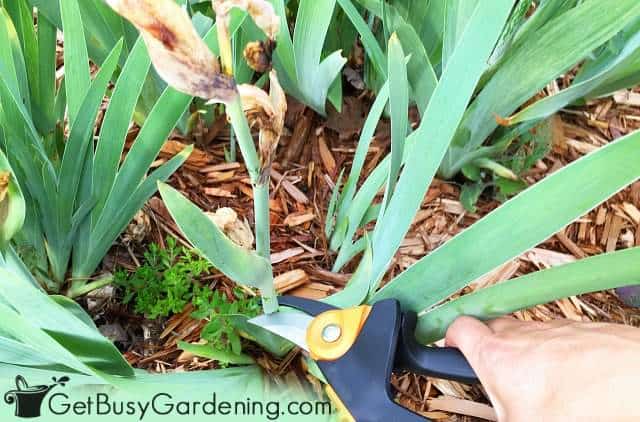
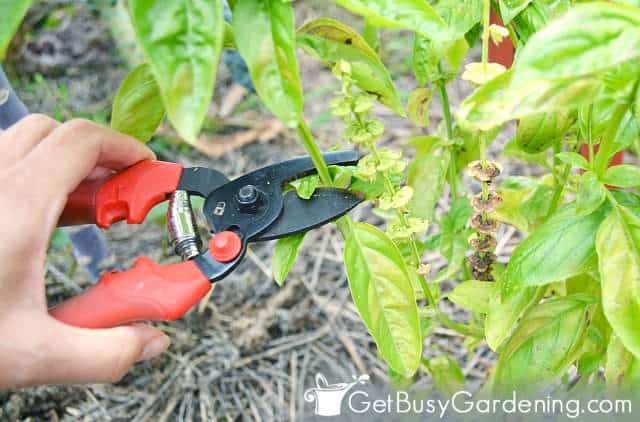

V Valencia says
Hello, Thank you for a great article on pruning! The front of our house had stone facade. We planted climbing fig vines to soften the look. Our gardener keeps it neat and trimmed. However, after years of growth, it has filled out and looks more like a hedge. I am just wondering if we were to do a heavy pruning, do you think it will survive? I am also finding these climbing fig roots have taken over and it has become difficult to grow other things near these vines. Ugh!
Amy Andrychowicz says
You’re welcome! If your vining plant looks more like a hedge, then it sounds like it’s being over pruned. But it really depends on the look you are going for. Some people prefer to keep vining plants well pruned, because they don’t like the overgrown look of the full sized plant. As long as there’s still new growth forming on the plant, then I think it will survive just fine if you stop pruning it so much, and allow it to grow taller.
Janice Goole says
Since retiring I have begun to garden and really enjoy it. Your tips on when and how to prune different plants and trees is very helpful. I have been doing some things incorrectly and plan to check you blog in the future to DO THINGS RIGHT!
Amy Andrychowicz says
Awesome, glad you found my pruning guide so helpful! 🙂
Vanessa D. says
I just bought a set of Fiskars loppers this year and it is amazing what they will cut through!
True story – my mother wanted me to use them to cut off a mullberry tree underground. I responded with “They’re brand new! I’m not cutting through dirt with them woman!” And this is why I keep them hid at the very back of my shed.
Amy Andrychowicz says
Haha, too funny! Thanks for sharing your story!
Sareer. Khan Gigyani says
I have started growing fruit plants after my retirement from airlines service. The main problem I face is to decide which branch is to cut and which one is to untouched during pruning. Can you give me some finger tips to solve my problem.
Amy Andrychowicz says
I don’t have a tutorial specifically about pruning fruit trees, but take a look at my basic tree trimming guide for more information and helpful tips.